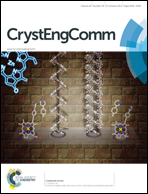Evaluation of structural transformation in 2D metal–organic frameworks based on a 4,4′-sulfonyldibenzoate linker: microwave-assisted solvothermal synthesis, characterization and applications†
Abstract
Six 2D metal–organic frameworks containing V-shaped 4,4′-sulfonyldibenzoate (SBA) linkers, [Zn3(SBA)2(OH)2]·EtOH (1 or CYCU-5·EtOH), [M3(OH)2(SBA)2(EtOH)(H2O)3]·3.5H2O (2–4, M = Mg, Ni, and Co), [Mn(SBA)(EtOH)] (5) and [Mn(SBA)(H2O)] (6), have been synthesized rapidly under microwave-assisted solvothermal conditions. The structural analysis revealed that all compounds display two-dimensional structures containing inorganic motifs with one-dimensional chains (1–5) or dimers of trigonal prisms (6) connected through SBA linkers and forming 2D neutral and porous channels. Compounds 1–4 were further characterized by elemental analysis, thermogravimetric analysis (TGA), powder X-ray diffraction (PXRD) measurements and IR spectroscopy. The desolvated phases of compounds 1–2/3–4 have thermal stabilities up to about 400/350 °C. The desolvated frameworks of 1–4 above 200 °C have similar CYCU-5-like conformations and exhibit gas adsorption properties with N2, CO2 and H2 gases. Interestingly, CYCU-5 displays selective adsorption of CO2 over N2 and CH4 gases at 273 K. In addition, the catalytic ability of CYCU-5 as an initiator for ring-opening polymerization of L-lactide has also been demonstrated.


 Please wait while we load your content...
Please wait while we load your content...